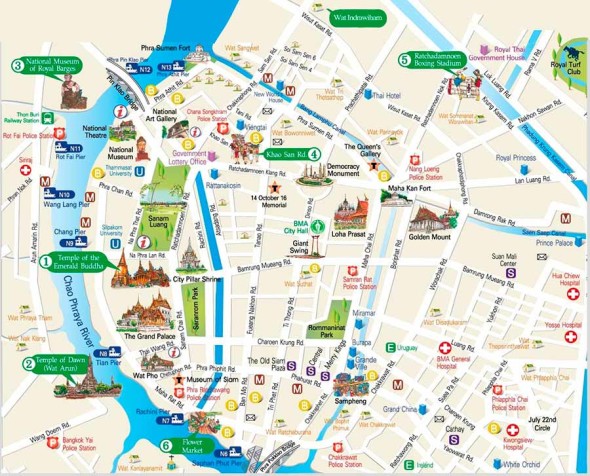When I was an EFL/ESL teacher in Thailand, there were some things I always taught a new EFL/ESL class. How to give directions in English easily. After all, most of my students were pretty bad at it.
They either didn’t know the vocabulary and grammar, or were so shy they didn’t want to explain correctly, or they really don’t know what information is necessary when giving directions.
This free EFL/ESL lesson plan worked to help my students overcome those problems and, if your students are having problems giving directions, it will help them too.
Expected Outcome: – EFL/ESL Students will be able to give simple but effective directions in English using correct vocabulary and grammar.
Materials and Resources: – Whiteboard markers, whiteboard, video camera (if you want to videotape the role plays), handout of directions grammar and vocabulary, maps.

Teaching Procedures:
Step One: Write on the whiteboard “Places of Interest in (the town your students are in)”. I’m in Bangkok, Thailand so I started out with the heading “Places of Interest in Bangkok”.
I then spent 10 minutes having my students give me examples of fun places to visit in Bangkok, and I wrote these on the whiteboard. Once we had about 25-30 places I stopped and moved on to Step Two. (10 minutes)
Step Two: Go through basic directions with your students, “Turn left”, “Turn right”, “Go Straight Ahead”, “It’s between the 7-11 and the church”, “Get off the train and walk in the direction the train is going” etc. I usually have my students give me the direction phrases they know themselves first, and then add ones they miss.
Once you have covered all basic directions, give them a handout of the direction phrases you have prepared before the class so they have it for their records. (10 minutes)
Step Three: Put students into pairs and hand out a map of a place to each student. I use Bangkok sky train maps, which are free from sky train stations, and have all the places of interest on them. If you can’t find free maps, just make some photocopies of a map, making sure that each student pair has the same map.
Now, pair by pair, tell them you are a visiting tourist and that you are at “Place A” and want to go to “Place B”. Then ask them to tell you how to get there. This is the fun part as my students love to find the places on the map and then figure out the best way to get there.
Should they use the skytrain, the underground, a taxi, a boat, walk? I correct them if there is an easier and faster way (especially in Bangkok, where the traffic is really bad) and I also correct the direction phrases they use or give them better ones if they are having trouble explaining. (20 minutes)
Step Four: In the last part of the lesson plan, keep your students in pairs and give them 5 minutes to come up with a quick role play where one is the tourist asking for directions and the other one is the local who gives the directions.
Then, in the last 15 minutes of the class, have several pairs (all of them, if you have a small class) act out their role plays, making corrections where necessary (20 minutes).
If they enjoy doing it, or you have a large class and everyone wants a turn to show off their role play, you can always carry it over to your next class with those students.
Expected Outcomes: Students will learn how to give directions correctly, learn new direction vocabulary and grammar and will also get more experience reading a map. It’s amazing how many EFL students aren’t familiar with places in their town, so if you use maps of their town, your students may learn more about that too!
Lesson Extensions – This is a really fun free lesson plan on how to give directions in English for EFL students. They quickly learn basic direction skills and how to apply them, and they have a lot of fun using the maps and trying to figure out easy ways to get to a place.
It is good for an hour class, but you can also use it in a class that’s 90 minutes or two hours. Just expand the time they spend giving directions from the maps (give them three or four locations together to give directions to), and more time on the role plays.
You can also add a discussion about the best places to visit in their city, as many students have different ideas about the cool places to go.
If you have a computer in your classroom, and you have more time than a typical one hour class, you can also show them the short video below on giving directions in English.

